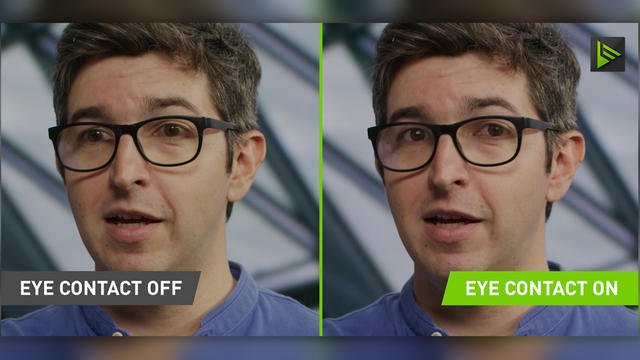NVIDIA EYE CONTACT AI FEATURE
The world of streaming will change thanks to Nvidia Eye Contact AI. The Nvidia Eye Contact, a new Nvidia Broadcast app feature, simulates your eyes as if you were looking at the camera using artificial intelligence (AI). The AI-powered feature alters your video in real-time so that you appear to be fixated on the camera when you are actually preoccupied.
What is the Nvidia Eye Contact AI feature?
With the help of artificial intelligence, a new feature dubbed "Eye Contact" in Nvidia Broadcast 1.4 replaces your eyes with "simulated" ones that are positioned in front of your camera. When you're not actually making eye contact with the camera, the Nvidia Eye Contact AI technology makes it appear that you are. As part of the 1.4 updates this month, Nvidia Broadcast, which enhances video for live-streaming and videoconferencing, unveiled a new feature dubbed Nvidia Eye Contact AI. Eye Contact is intended for creators who want to look directly into the camera at all times, even if they have to glance away from the action to do anything like read notes or a screenplay, according to a blog post by Nvidia. The Eye Contact feature is just one more example of how artificial intelligence is progressively being incorporated into daily life. Nvidia claims that Eye Contact offers a "disconnect option in case you look too far away" and will make an effort to match the color of your virtual eyes to those of your actual ones. The beta badge denotes that Nvidia is actively looking for community feedback to advance and enhance functionality.
Broadcast also has background replacement, which may be used as a virtual green screen, and the ability to cancel out any unpleasant noises picked up by your microphone. These capabilities are both powered by artificial intelligence (AI). Nvidia released Broadcast version 1.4 with more features than just Eye Contact. The most recent update improves the Virtual Background Blur, Replacement, and Removal effects and also includes a vignette effect that Nvidia claims is comparable to Instagram's. For those who have an RTX graphics card, you can download the update. The new technology has alarmed users due to its artificial appearance and feel. There are, however, a lot more encouraging remarks to be discovered. Do you want to give it a go? Check first to see if you can fulfill the requirements.
Nvidia Eye Contact requirements
The software requires a minimum of 8 GB of RAM and a GeForce RTX 2060 graphics card (or a Quadro-compatible substitute). As a bare minimum CPU, NVIDIA advises using a Core i5-8600 or Ryzen 5 2600.
The Nvidia Eye Contact AI feature could feel awkward at first to use. Being glared upon by an artificially flawless avatar could be unnerving because even the most accomplished presenters periodically turn away. However, if you feel uncomfortable making eye contact with the camera, this could help you connect with your viewers. Does your machine satisfy these specifications? If so, let's look more closely at how to obtain and utilize it.

How to get the Nvidia Eye Contact AI feature?
Get your PC or laptop the most recent NVIDIA Broadcast (1.4) version. Your menu will now include the Nvidia Eye Contact feature after the upgrade.
How to use the Nvidia Eye Contact AI feature?
• If you haven’t downloaded it yet, download Nvidia Broadcast. You can use this link.
• Go to Camera
• Click Effect
• Select Eye Contact (Beta)
Another illustration of how AI is becoming user-friendly for regular consumers is the Eye Contact feature. Due of its natural-language output, ChatGPT—which can be used for a variety of purposes, including composing essays—became an overnight success. Various other programs, such as DALL-E, Midjourney, and Free AI Art Generator, are used to make memes and imitate the aesthetic of particular directors' films.
In order to make it appear as though you are constantly staring at the camera, even when you aren't, NVIDIA's new Eye Contact AI is said to be able to accomplish precisely that. Anyone watching the video advertisements they have produced would be hard-pressed to tell if you are genuinely paying attention because of how much they resemble real life. Amazingly, the AI still functions when the user is using their phone and has other objects in front of their face. Many people who have trouble keeping eye contact have welcomed the technology despite the fact that it may feel unsettling and could use some minor tuning to make the stare less intense. Eye contact can be awkward for certain people, especially individuals with autism spectrum disorder (ASD), making them appear disinterested in conversations. Such individuals could feel more at ease in meetings if eye contact is maintained.